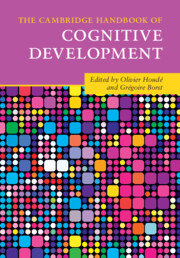Book contents
- The Cambridge Handbook of Cognitive Development
- The Cambridge Handbook of Cognitive Development
- Copyright page
- Contents
- Figures
- Tables
- Contributors
- Introduction
- Part I Neurobiological Constraints and Laws of Cognitive Development
- Part II Fundamentals of Cognitive Development from Infancy to Adolescence and Young Adulthood
- Introduction
- Subpart II.1 Infancy: The Roots of Human Thinking
- Subpart II.2 Childhood and Adolescence: The Development of Human Thinking
- 15 Development of Qualitative Thinking
- 16 Development of Numerical Knowledge
- 17 Numerical Cognition and Executive Functions
- 18 Developing Theory of Mind and Counterfactual Reasoning in Children
- 19 Development of Executive Function Skills in Childhood
- 20 Developing Cognitive Control and Flexible Adaptation during Childhood
- 21 Reasoning Bias and Dual Process Theory
- 22 Social Cognitive Development
- 23 Behavioral and Neural Development of Cognitive Control and Risky Decision-Making across Adolescence
- 24 The Triadic Neural Systems Model through a Machine-Learning Mill
- Part III Education and School-Learning Domains
- Index
- Plate Section (PDF Only)
- References
24 - The Triadic Neural Systems Model through a Machine-Learning Mill
from Subpart II.2 - Childhood and Adolescence: The Development of Human Thinking
Published online by Cambridge University Press: 24 February 2022
- The Cambridge Handbook of Cognitive Development
- The Cambridge Handbook of Cognitive Development
- Copyright page
- Contents
- Figures
- Tables
- Contributors
- Introduction
- Part I Neurobiological Constraints and Laws of Cognitive Development
- Part II Fundamentals of Cognitive Development from Infancy to Adolescence and Young Adulthood
- Introduction
- Subpart II.1 Infancy: The Roots of Human Thinking
- Subpart II.2 Childhood and Adolescence: The Development of Human Thinking
- 15 Development of Qualitative Thinking
- 16 Development of Numerical Knowledge
- 17 Numerical Cognition and Executive Functions
- 18 Developing Theory of Mind and Counterfactual Reasoning in Children
- 19 Development of Executive Function Skills in Childhood
- 20 Developing Cognitive Control and Flexible Adaptation during Childhood
- 21 Reasoning Bias and Dual Process Theory
- 22 Social Cognitive Development
- 23 Behavioral and Neural Development of Cognitive Control and Risky Decision-Making across Adolescence
- 24 The Triadic Neural Systems Model through a Machine-Learning Mill
- Part III Education and School-Learning Domains
- Index
- Plate Section (PDF Only)
- References
Summary
Fifteen years ago, the triadic neural systems model was proposed as a heuristic tool to study and clarify the neural mechanisms accounting for distinct typical adolescent behaviors. Whereas aspects of the models have been validated, the overall theory has not been comprehensively tested, mainly because of the lack of appropriate samples (i.e., large pediatric sample with follow-ups) and sufficiently powerful analytic tools. This situation can be remediated now, thanks to the availability of large longitudinal datasets and the emergence of machine learning (ML) tools in the neuroscience field. This chapter describes a “vision” of how the triadic neural systems model could be tested using ML methodology. In the name of clarity, fictitious concrete examples are presented, together with a concerted effort to keep this essay quite simple and accessible to the majority of clinical researchers. This comes at the expense of a critical review of assumptions and limitations that accompanies any analytical strategy. To mitigate this caveat, references to comprehensive publications are provided.
- Type
- Chapter
- Information
- The Cambridge Handbook of Cognitive Development , pp. 516 - 534Publisher: Cambridge University PressPrint publication year: 2022



